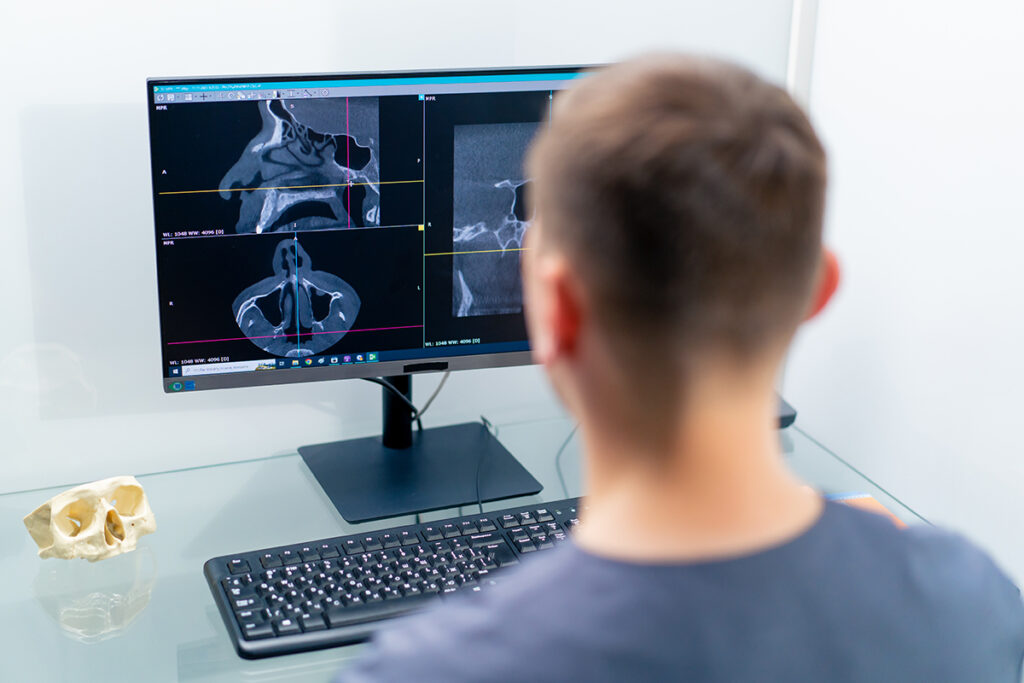What is Maxillary Antrostomy?
Maxillary antrostomy is a surgical procedure that widens the opening of the maxillary sinus to improve sinus drainage. It is commonly employed to address chronic sinusitis that has not responded to conservative treatments.
Exploring the Maxillary Sinus and its Role in Sinus Health
The maxillary sinus is the largest pair of paranasal sinuses, situated within the maxillary bone and close to the roots of the posterior upper teeth. Dental infections can lead to maxillary sinusitis due to this proximity. Other contributing factors to maxillary sinusitis include allergic rhinitis, trauma, and deviated nasal septum.
By performing maxillary antrostomy, the natural opening of the maxillary sinuses is widened, facilitating improved drainage. This reduces the likelihood of future sinusitis episodes and promotes overall sinus health.
Procedure: How is the Maxillary Antrostomy Performed
Maxillary antrostomy aims to widen the opening of your maxillary sinus. This can involve the following steps:
- Removal of the uncinate process: Your surgeon may remove the uncinate process, which is the L-shaped bone found on the later nasal wall.
- Identification and enlargement of the natural opening: The surgeon will carefully locate and enlarge the natural opening of the maxillary sinus to improve drainage and airflow.
- Polyp removal: If polyps are present inside the maxillary sinus cavity, they may be removed during the procedure to alleviate symptoms and improve sinus health.
Will Maxillary Antrostomy Hurt?
Maxillary antrostomy is performed under general anesthesia. With the administration of general anesthesia, you’ll be asleep for the procedure, and your healthcare team will monitor your vital signs. Additionally, your ENT surgeon will apply local anesthesia to improve patient recovery and avoid the activation of deep pain pathways.
How Long is the Maxillary Antrostomy Procedure?
The maxillary antrostomy procedure typically ranges from 1 to 3 hours, depending on the severity and complexity of the maxillary sinusitis being addressed.
Step-by-Step Breakdown of Maxillary Antrostomy Surgery
Here are the steps you can expect when undergoing maxillary antrostomy:
What to Expect Before the Surgery
Before your maxillary antrostomy surgery, your healthcare team will ensure you’re well-prepared. Your doctor will answer your inquiries about the procedure before the surgery. If you have an active infection, significant edema, or nasal polyps, your doctor may prescribe medication to alleviate these conditions in the weeks leading up to the surgery.
Additionally, you may be given oxymetazoline spray to decongest your nose, facilitating easier identification of the natural openings of your maxillary sinus during the procedure.
Your anesthesiologist will also discuss your anesthetic plan with you before the surgery to minimize any discomfort.
What to Expect During the Surgery
During the maxillary antrostomy surgery, your ENT surgeon will perform the following steps:
- Insertion of an endoscope: Your surgeon will insert a narrow tube called an endoscope through your nose. The endoscope contains a small camera and light on its end. It helps the surgeon guide the small surgical instruments used to widen the maxillary sinus opening.
- Widening of the maxillary sinus opening: First, the uncinate process is gently removed. Then, the opening of your maxillary sinus is identified and enlarged. If there are any polyps present in the sinus, they are also removed.
- Potential packing: In some cases of postoperative bleeding, your surgeon may apply packing, typically removed during the follow-up visit within 3-5 days.
What to Expect After Surgery
After the surgery, you will be transferred to the postoperative care unit for recovery. Once you are awake and stable, a healthcare provider will assess for any signs of complications, such as facial nerve injury or excessive bleeding.
Once your recovery is confirmed, you will receive instructions for home care, including any prescribed medications and the date of your follow-up visit. Remember to communicate any questions or concerns with your doctor during this time.
Risks and Benefits of Maxillary Antrostomy
Like all surgeries, maxillary antrostomy comes with its own set of risks and benefits.
Risks
While generally safe, maxillary antrostomy carries the normal risks associated with surgical procedures performed under general anesthesia. There is also a possibility of instrument-related damage to parts of the sinus during the procedure. Some of the rare risks and associated complications include:
- Blindness
- Eye area injury
- Tear duct injury
- Nosebleed
- Runny nose due to cerebrospinal fluid leakage
- Meningitis
It’s important to note that while these risks exist, they are uncommon occurrences. Choosing a skilled rhinologist to perform the surgery is essential in minimizing these risks and ensuring a successful outcome.
Benefits
Postoperative care is crucial for optimal recovery after maxillary antrostomy surgery. This includes removing crusts and carefully monitoring the healing process. Depending on your health and symptoms, it can take up to three months or even longer.
However, maxillary antrostomy has significant benefits. It can enhance your quality of life with better sinus drainage and reduce the risk of sinusitis. With better airflow and less inflammation, you’ll experience improved breathing and fewer sinus-related issues.
Why Choose Puget Sound Sinus Center for Maxillary Antrostomy?
When considering maxillary antrostomy surgery, expertise and experience are paramount. You can trust our commitment to providing expert, state-of-the-art care under the guidance of Dr. Amy Anstead, a seasoned specialist with decades of experience in sinus surgery.
For a clearer head and easier breathing, schedule an appointment with us today. Experience the difference that expert care can make in your journey to sinus relief.


